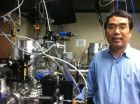(Press-News.org) Disease-free survival for invasive ductal breast cancer (IDC) patients may be easier to predict with the help of F-18-fludeoxyglucose positron emission tomography (PET)/computed tomography (CT) scans, according to research published in the September issue of The Journal of Nuclear Medicine. New data show that high maximum standard uptake value (SUVmax) of F-18-FDG in the lymph nodes prior to treatment could be an independent indicator of disease recurrence.
"Many studies have revealed that breast cancer patients with axillary lymph node metastasis have a significantly poorer prognosis than those without nodal metastases," noted Sang-Woo Lee, MD, PhD, one of the authors of "F-18-FDG Uptake by Metastatic Axillary Lymph Nodes on Pretreatment PET/CT as a Prognostic Factor for Recurrence in Patients with Invasive Ductal Breast Cancer." "However, the prognostic value of F-18-FDG uptake in metastatic axillary lymph nodes with PET/CT has not been investigated in IDC patients," he added.
In the study, researchers followed 65 female patients with IDC who had undergone pretreatment F-18-FDG PET/CT and who had pathologically confirmed axillary lymph node involvement without distant metastases. Factors such as age, TNM (tumor, lymph node and metastases) stage, estrogen receptor status, progesterone receptor status, human epidermal growth factor receptor 2 status, and SUVmax for the primary-tumor and axillary lymph nodes were analyzed. Patients underwent treatment and were followed for a range of 21-57 months (median of 36 months).
Among the patients, 53 were disease-free and 12 had disease recurrence during the follow-up period. While both the primary-tumor and nodal SUVmax were higher in patients with recurrence, the nodal SUVmax was significantly higher. In addition, compared to the other factors that were analyzed, only nodal SUVmax was found to be an independent determinant of disease-free survival. Using a receiver-operating-characteristic curve, the researchers demonstrated that a nodal SUVmax of 2.8 was the optimal cutoff for predicting disease-free survival.
"One of the important roles of molecular imaging in cancer research is to noninvasively predict precise prognosis. Our results showed significant improvement in the accuracy of risk prediction for disease-free survival rates when nodal SUVmax was added to well-known established risk factors," said Lee. "Our study suggests that 18F-FDG PET/CT could yield useful information for risk stratification and treatment strategies in IDC patients with axillary lymph node involvement."
An estimated one in eight women will develop breast cancer in her lifetime. According to the American Cancer Society, an estimated 280,000 new cases of breast cancer were diagnosed among women in 2011, and nearly 40,000 died from the disease.
###
Authors of the article "F-18-FDG Uptake by Metastatic Axillary Lymph Nodes on Pretreatment PET/CT as a Prognostic Factor for Recurrence in Patients with Invasive Ductal Breast Cancer" include Bong-Il Song, Sang-Woo Lee, Shin Young Jeong, Byeong-Cheol Ahn and Jaetae Lee, Department of Nuclear Medicine, Kyungpook National University Hospital, Daegu, Korea; Yee Soo Chae, Department of Internal Medicine. Kyungpook National University Hospital, Daegu, Korea; and Won Kee Lee, Center of Biostatistics, School of Medicine, Kyungpook National University Hospital, Daegu, Korea.
Pretreatment PET/CT imaging of lymph nodes predicts recurrence in breast cancer patients
2012-09-05
ELSE PRESS RELEASES FROM THIS DATE:
Realizing the promise of RNA nanotechnology for new drug development
2012-09-05
New Rochelle, NY, September 4, 2012—The use of RNA in nanotechnology applications is highly promising for many applications, including the development of new therapeutic compounds. Key technical challenges remain, though, and the challenges and opportunities associated with the use of RNA molecules in nanotechnology approaches are presented in a review article in Nucleic Acid Therapeutics, a peer-reviewed journal from Mary Ann Liebert, Inc. The article is available free online at the Nucleic Acid Therapeutics website.
Peixuan Guo and colleagues, University of Kentucky, ...
Waste not, power up
2012-09-05
HOUSTON – (Sept. 4, 2012) – Researchers at Rice University and the Université catholique de Louvain, Belgium, have developed a way to make flexible components for rechargeable lithium-ion (LI) batteries from discarded silicon.
The Rice lab of materials scientist Pulickel Ajayan created forests of nanowires from high-value but hard-to-recycle silicon. Silicon absorbs 10 times more lithium than the carbon commonly used in LI batteries, but because it expands and contracts as it charges and discharges, it breaks down quickly.
The Ajayan lab reports this week in the journal ...
UCF researchers record world record laser pulse
2012-09-05
A University of Central Florida research team has created the world's shortest laser pulse and in the process may have given scientists a new tool to watch quantum mechanics in action – something that has been hidden from view until now.
UCF Professor Zenghu Chang from the Department of Physics and the College of Optics and Photonics, led the effort that generated a 67-attosecond pulse of extreme ultraviolet light. The results of his research are published online under Early Posting in the journal Optics Letters.
An attosecond is an incomprehensible quintillionith ...
Human impact felt on Black Sea long before industrial era
2012-09-05
When WHOI geologist Liviu Giosan first reconstructed the history of how the Danube River built its delta, he was presented with a puzzle.
In the delta's early stages of development, the river deposited its sediment within a protected bay. As the delta expanded onto the Black Sea shelf in the late Holocene and was exposed to greater waves and currents, rather than seeing the decline in sediment storage that he expected, Giosan found the opposite. The delta continued to grow. In fact, it has tripled its storage rate.
If an increase in river runoff was responsible for ...
U of M faculty find antimicrobials altering intestinal bacteria composition in swine
2012-09-05
MINNEAPOLIS/ST. PAUL (09/04/2012) — Researchers from the University of Minnesota's College of Veterinary Medicine, concerned about the use of antibiotics in animal production, have found that antimicrobial growth promoters administered to swine can alter the kind of bacteria present in the animal's intestinal track, resulting in an accelerated rate of growth and development in the animals.
Antibiotics are routinely administered to swine to treat illness and to promote larger, leaner animals.
The results of the study, conducted by Richard Isaacson, Ph.D., microbiologist ...
Little evidence of health benefits from organic foods, Stanford study finds
2012-09-05
You're in the supermarket eyeing a basket of sweet, juicy plums. You reach for the conventionally grown stone fruit, then decide to spring the extra $1/pound for its organic cousin. You figure you've just made the healthier decision by choosing the organic product — but new findings from Stanford University cast some doubt on your thinking.
"There isn't much difference between organic and conventional foods, if you're an adult and making a decision based solely on your health," said Dena Bravata, MD, MS, the senior author of a paper comparing the nutrition of organic ...
Showing the way to improved water-splitting catalysts
2012-09-05
PASADENA, Calif.—Scientists and engineers around the world are working to find a way to power the planet using solar-powered fuel cells. Such green systems would split water during daylight hours, generating hydrogen (H2) that could then be stored and used later to produce water and electricity. But robust catalysts are needed to drive the water-splitting reaction. Platinum catalysts are quite good at this, but platinum is too rare and expensive to scale up for use worldwide. Several cobalt and nickel catalysts have been suggested as cheaper alternatives, but there is still ...
Repeated exposure to traumatic images may be harmful to health
2012-09-05
Irvine, Calif., Sept. 4, 2012 – Repeated exposure to violent images from the terrorist attacks of Sept ember 11 and the Iraq War led to an increase in physical and psychological ailments in a nationally representative sample of U.S. adults, according to a new UC Irvine study.
The study sheds light on the lingering effects of "collective traumas" such as natural disasters, mass shootings and terrorist attacks. A steady diet of graphic media images may have long-lasting mental and physical health consequences, says study author Roxane Cohen Silver, UCI professor of psychology ...
A blueprint for 'affective' aggression
2012-09-05
A North Carolina State University researcher has created a roadmap to areas of the brain associated with affective aggression in mice. This roadmap may be the first step toward finding therapies for humans suffering from affective aggression disorders that lead to impulsive violent acts.
Affective aggression differs from defensive aggression or premeditated aggression used by predators, in that the role of affective aggression isn't clear and could be considered maladaptive. NC State neurobiologist Dr. Troy Ghashghaei was interested in finding the areas of the brain engaged ...
Vitamin D supplements do not improve cholesterol as previous research suggested
2012-09-05
Vitamin D has been touted for its beneficial effects on a range of human systems, from enhancing bone health to reducing the risk of developing certain cancers. But it does not improve cholesterol levels, according to a new study conducted at The Rockefeller University Hospital. A team of scientists has shown that, at least in the short term, cholesterol levels did not improve when volunteers with vitamin D deficiency received mega-doses of vitamin D. The finding is published in the journal Arteriosclerosis, Thrombosis and Vascular Biology.
The researchers, led by Manish ...




